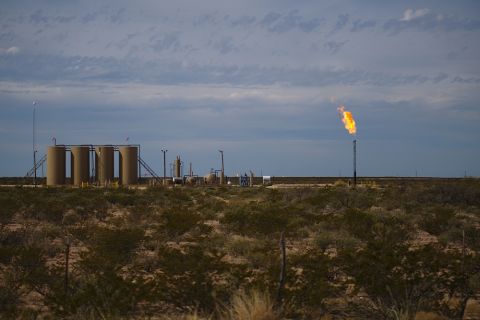With few cheap and easy prospects for boosting reserves and production, mergers and acquisitions may help define the credit-worthy from the unworthy in the near-term, according to Standard & Poor's Ratings Services. "Accelerating depletion rates, an easy fund-raising environment for companies of good credit quality, and a pricing disparity between the value of a company's reserves implied by the futures strip and the price recognized by the equity market could ignite activity," S&P's analysts report in their latest "Industry Report Card: Oil & Gas." Sitting on the sidelines of the next asset-rush will be those still paying-some of them dearly-for their past acquisitions. "Companies that incur substantial debt through M&A activity are likely to be candidates for downgrades," the analysts warn. Their analysis is based on an assumption of an average West Texas Intermediate price of $24.75 per barrel and an average Nymex gas price of $4.15 per million Btu for 2003. They expect they may need to revise the latter, upward: the 2003 futures strip was about $5.15 per MMBtu on April 14, they note. An upward revision could change their outlook for most of the rated companies' credit-worthiness too. Meanwhile, their outlooks for several companies are not positive. Watch for possible asset sales from some of these during the next 12 months to correct these problems, or at least to not run into them in other companies' datarooms. Following are some of the analysts' notes. • Newfield Exploration Co. is rated BB+ (investment-grade for publicly held E&P companies, which want to redeploy spare cash and use debt to grow) but the outlook is negative due to its aggressive fiscal policy. Also, it has not deleveraged from its acquisition of EEX Corp. "However, strong natural gas prices should provide it with the capacity to improve its financial profile," the analysts add. "Until leverage is reduced, Newfield has no flexibility for additional leveraged transactions at the current rating." • Amerada Hess Corp. is rated a strong BBB but the outlook is negative while the analysts believe the company's production cuts for 2003-05 will prevent it from deleveraging much anytime soon. "Through a combination of underperformance, likely asset sales, and delays in bringing new production onstream, Hess is facing 2003 and 2004 production levels that are about 20% lower than 2002." • The Wiser Oil Co. is rated B (a couple of steps from junk) and the outlook is negative. Its gas production has grown-due to its 2001 acquisition of Invasion Energy and from joint ventures in the Gulf of Mexico-but it has near-term liquidity issues. • Vintage Petroleum Corp. is rated BB- (slipping away from investment-grade) and the outlook is negative. More than 30% of its production is from Argentina, which has a dubious risk profile, and it will lose some production due to fund-raising asset sales-at a time when it doesn't have much cash to throw at capex. As for the supermajors, they have strong credit profiles, but the sub-supermajors, such as Amerada Hess Corp. and Marathon Oil Corp., are pursuing growth strategies that "overweight upstream operations, frequently through acquisitions that are not good for credit quality," the analysts report. They add that some of the integrated oils have underfunded pension funds, and they're currently reviewing the implications of this on the companies' long-term financial health. "Most companies will have ample cash flow in 2003 to make expected pension funding contributions without materially affecting cash flow," they add. -Nissa Darbonne
Recommended Reading
Kinder Morgan Sees Need for Another Permian NatGas Pipeline
2024-04-18 - Negative prices, tight capacity and upcoming demand are driving natural gas leaders at Kinder Morgan to think about more takeaway capacity.
Waha NatGas Prices Go Negative
2024-03-14 - An Enterprise Partners executive said conditions make for a strong LNG export market at an industry lunch on March 14.
Targa Expects Another Major Permian Pipeline Project This Year
2024-05-03 - Targa Resources says different projects are falling in place for gas capacity expansion
Enbridge Fortifies Dominant Role in Corpus Christi Crude Transport
2024-03-20 - Colin Gruending, Enbridge executive vice president and president for liquids pipelines told Hart Energy the company’s holdings in South Texas are akin to a “catcher’s mitt” for Permian and Haynesville production.
Enbridge Announces $500MM Investment in Gulf Coast Facilities
2024-03-06 - Enbridge’s 2024 budget will go primarily towards crude export and storage, advancing plans that see continued growth in power generated by natural gas.





